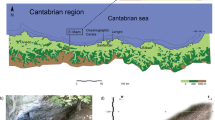Abstract
From 1979 to 1983 a population ofMeganyctiphanes norvegica was regularly found in a confined location in the northern Kattegat. The development of this pelagic population was followed over one complete year-cycle, and is discussed in light of published data on landlocked and oceanic populations. In the Kattegat,M. norvegica mature at the age of 9 to 12 months. Copulation starts in january, but fully developed spermatophores are present in males for at least 9 months. Spawning starts in April and continues until October with a marked peak in July. As only 10 to 15% of the gravid females belong to the II-group, it is concluded that recruitment is due to the I-group. Linear growth is fastest in spring and early summer, rises to a second maximum in October and stagnates during winter. The weight development shows some discontinuties caused by spawning or the accumulation of reserves towards winter. Weight decreases during winter. Growth in length and in weight runs largely parallel in both sexes, and can be closely correlated with the prevailing food supply. Diurnal vertical migration could be demonstrated. The results indicate a continuous development, which suggests the existence of an autonomous palagic population, a well suited subject for long-term investigation.
Similar content being viewed by others
Literature cited
Båmstedt, U.: Studies on the deep water pelagic community of Korsfjorden: changes in size and biochemical composition ofMeganyctiphanes norvegica in relation to its life cycle. Sarsia61, 15–30 (1976)
Berkes, F.: Ecology of euphausiids in the Gulf of St. Lawrence. J. Fish. Res. Bd Can.33, 1894–1905 (1976)
Cassie, R. M.: The analysis of polymodal frequency distributions by the probability paper method. N. Z. Sci. Rev.8, 89–91 (1950)
Cassie, R. M.: Some use of probability paper in the analysis of frequency distributions. Austr. J. mar. freshw. Res.5, 513–522 (1954)
Durbin, E. G. and A. G. Durbin: Length and weight relationships ofAcartia clausi from Narragansett Bay. R. I. Limnol. Oceanogr.23, 958–969 (1978)
Einarsson, H.: Euphausiacea, I Northern Atlantic species. Dana Report27, 1–175 (1945)
Falk-Petersen, S.: Ecological investigations on the zooplankton community of Balsfjorden, Northern Norway: seasonal changes in the main biochemical composition. J. exp. mar. Biol. Ecol.49, 103–120 (1981)
Falk-Petersen, S. and C. C. E. Hopkins: Ecological investigations on the zooplankton community of Balsfjorden, Northern Norway: population dynamics of the euphausiidsThysanoessa inermis, Thysanoessa raschii andMeganyctiphanes norvegica. J. Plankt. Res.3, 177–192 (1981)
Falk-Petersen, S., R. R. Gatten, J. R. Sargent and C. C. E. Hopkins: Ecological investigations on the zooplankton community in Balsfjorden, Northern Norway: seasonal changes in the lipid class composition ofMeganyctiphanes norvegica, Thysanoessa raschii andThysanoessa inermis. J. exp. mar. Biol. Ecol.54, 209–224 (1981)
Fisher, L. R. and E. H. Gouldie: The food ofMeganyctiphanes norvegica with an assessment of the contribution of its components to the vitamin A reserves of the animal. J. mar. biol. Assoc. U.K.38, 291–312 (1959)
Hansen, K. v.: On the diurnal migration of zooplankton in relation to the discontinuity layer. J. Cons. int. Explor. Mer.17, 231–241 (1950)
Harding, J. P.: The use of probability paper for the graphical analysis of polymodal frequency distributions. J. mar. biol. Ass. U.K.28, 141–154 (1949)
Klages, N.: Der nordische KrillMeganyctiphanes norvegica (M. Sars). Nahrung und ernährungsethologische Aspekte, 104 pp. Dissertation. University of Kiel 1983
Lucas, C. E., N. B. Marshall and C. B. Rees: Continuous Plankton Records: The Faroe-Shetland-Channel 1939. Hull. Bull. Mar. Ecol.2, 71–94 (1957)
Makarov, R. R. and C. J. Denys: Stages of sexual maturity ofEuphausia superba, 13 pp. Biomass Handbook no. 11, 1981
Macdonald, R.: Food and habits ofMeganyctiphanes norvegica. J. mar. biol. Ass. U.K.14, 753–784 (1927)
Matthews, J. B.: Ecological studies on the deep water pelagic community of Korsfjorden, Western Norway: population dynamics ofMeganyctiphanes norvegica in 1968 and 1969. Sarsia54, 75–90 (1973a)
Matthews, J. B.: The succession of generations in a population ofMeganyctiphanes norvegica, with an estimate of energy flux. Int. C. Explor. Sea61, Stat. Mtg. Plankton Cttee. L 19, 12 (1973b)
Mauchline, J.: The biology of the euphausiid crustaceanMeganyctiphanes norvegica. Proc. R. Soc. Edinburgh Sect. B67, 1957–1960 (1960)
Mauchline, J.: The biology ofThysanoessa raschii with a comparison of its diet with that ofMeganyctiphanes norvegica.In: Some contemporary studies in marine science, pp 493–510. Ed. by H. Barnes. London: George Allen and Unwin Ltd. 1966
Mauchline, J. and L. R. Fisher: The biology of euphausiids, Vol. 7, 454 pp. London and New York:Academic Press 1969
Poulsen, E. M.: Om den store lyskrebs betydning som fiskefødi i Skagerak Dansk Fisk. Tid.24, 286–289 (1926)
Raymont, J. E. G., R. T. Srinivagasm and J. K. B. Raymont: Biochemical studies on zooplankton VIII: further investigation onMeganyctiphanes norvegica. Deep Sea Res.18, 1167–1178 (1971)
Ruud, J. T.: Euphausiacea. Rep. Danish oceanogr. Exped. Medit.2, 1–86 (1936)
Tesch, F. W.: Age and growth. A manual on methods for the assessment of secondary production in waters. pp 98–130. Ed. by W. Ricker. IBP Handbook No 17, Oxford-Edinburgh: Blackwell Scientific Publications 1971
Ulrich, J. Zur Bathymetrie und Topographie der nördlichen Kattegat-Rinne. Meeresforsch.30, 61–68 (1983)
UNESCO: Determination of photosynthetic pigments in sea water. Monographs on oceanographic methodology 1, 69 pp. Paris: UNESCO 1966
Weber, E.: Grundriß der biologischen Statistik 652 pp. Stuttgart, New York: Fischer Verlag 1980
Wiborg, K. F.: Investigation on the euphausiids in some fjords on the west coast of Norway in 1966–1969. Fisk. Dir. Skr. Ser. Havundersøk.16, 10–35 (1971)
Wiebe, P. H., K. H. Burt, St. H. Boyd and A. W. Morton: A multiple opening/closing net and environmental sensing system for sampling zooplankton. J. mar. Res.34, 313–326 (1976)
Author information
Authors and Affiliations
Additional information
Communicated by O. Kinne, Hamburg
Rights and permissions
About this article
Cite this article
Boysen, E., Buchholz, F. Meganyctiphanes norvegica in the Kattegat. Mar. Biol. 79, 195–207 (1984). https://doi.org/10.1007/BF00951828
Accepted:
Issue Date:
DOI: https://doi.org/10.1007/BF00951828




